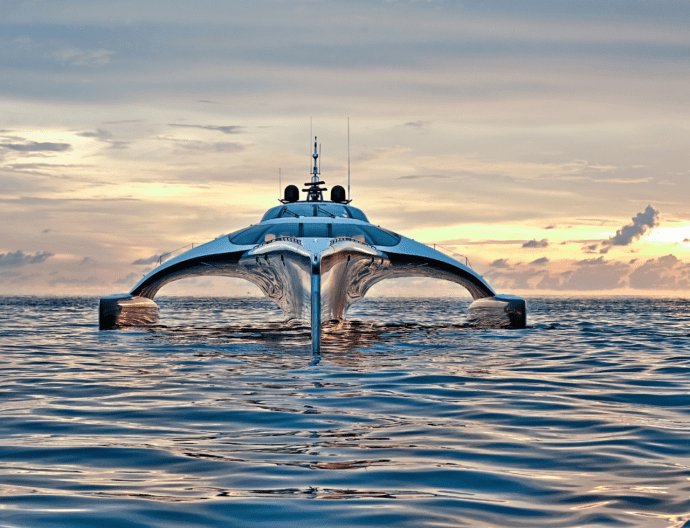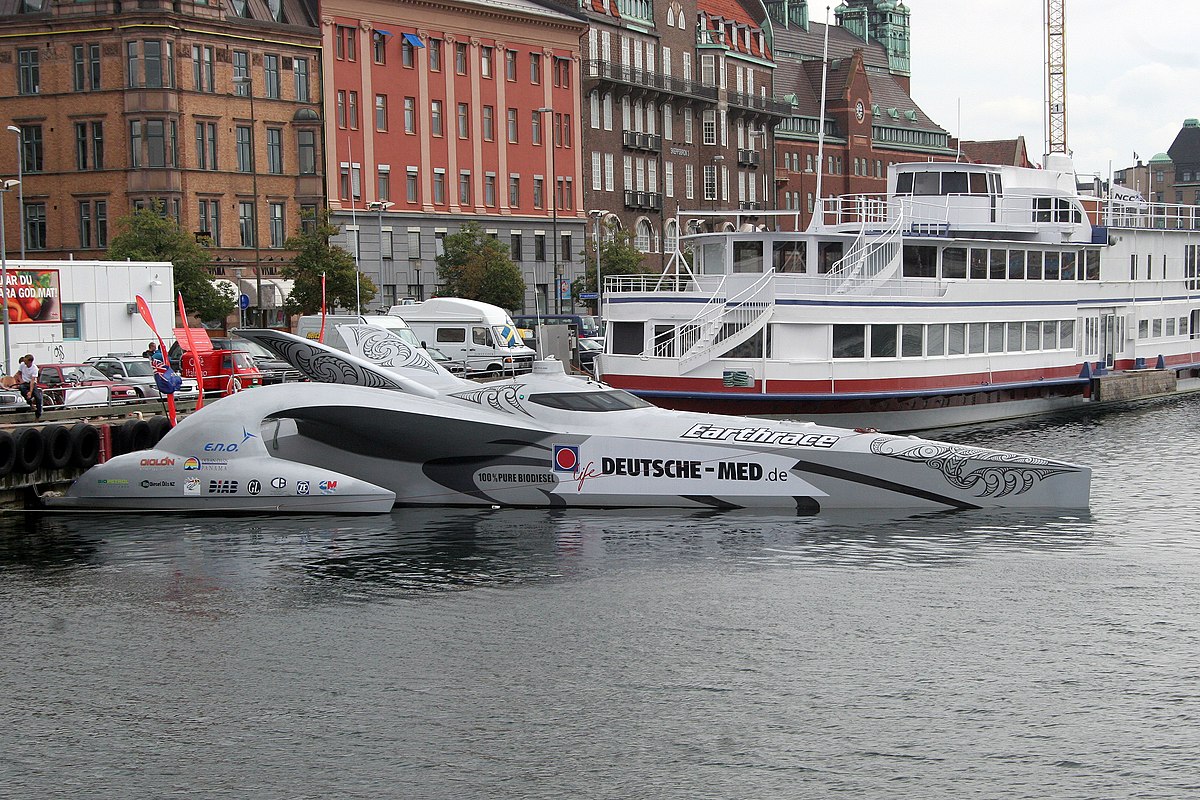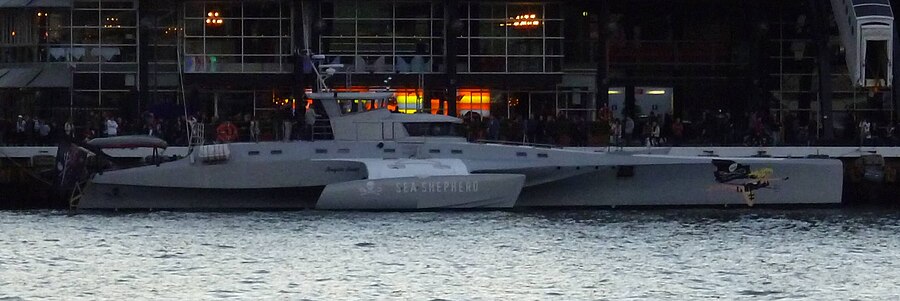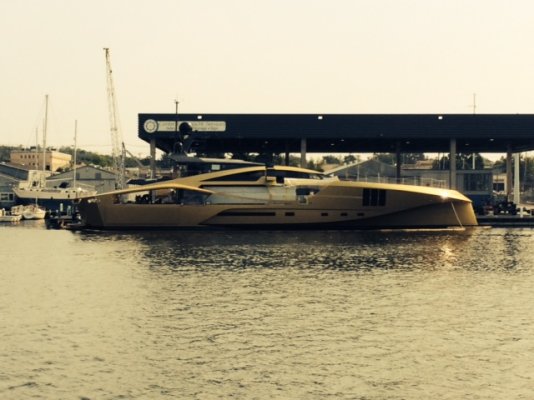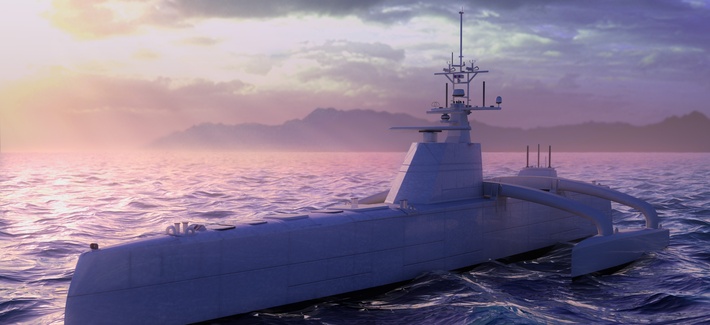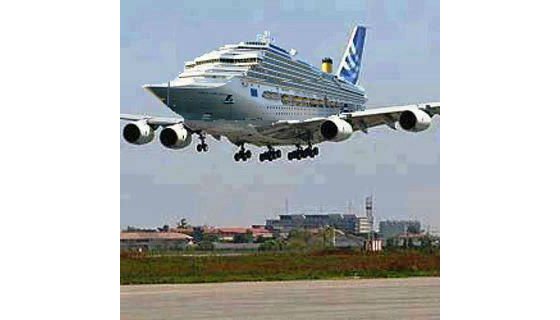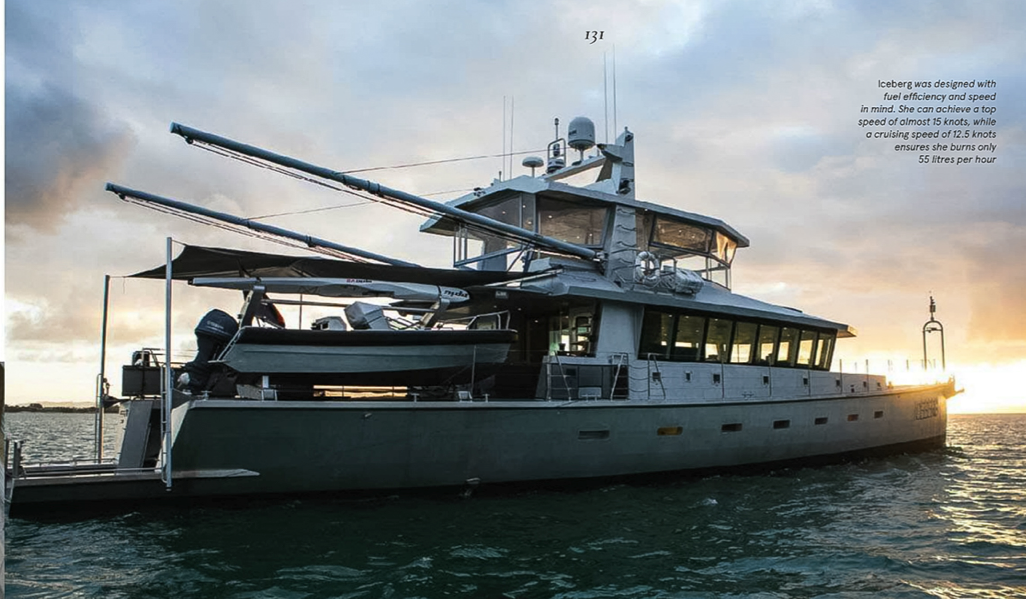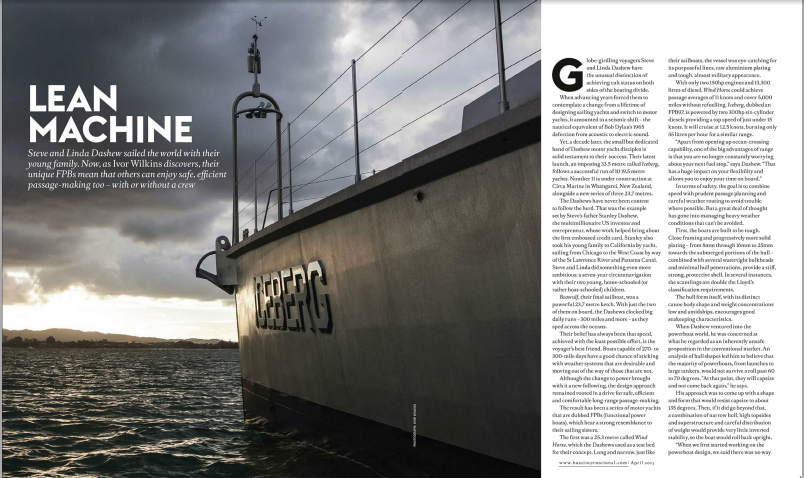Governments are ordering some new ultra long and thin trimarans it seems - here is a new 43 meter boat coming down the pipe. Seems like the design might make an interesting starting point for a line of long range passagemakers...
The Ocean Eagle 43 is an innovative OPV (Offshore Patrol Vessel) that has been designed to offer a cost effective and reliable vessel for governments and research agencies to operate for extended periods at sea.
Ocean Eagle 43 trimaran will have a range of over 3,000 nautical miles and a top speed of 30 knots whilst burning around one-fifth of the fuel of an equivalent single hull OPV.
Built in lightweight composites and powered by four 500hp engines, the 75 tonne vessel can be operated by eight crew or less offering a much lower cost of ownership, both in build and operation, than an equivalent single-hull ship without compromising the operational performance and ability to carry out effective patrols.


A response to the changing needs of modern navies with greatly reduced acquisition and operations budgets, the Ocean Eagle 43 is a light ocean patrol vessel (OPV) that makes use of modern electronics for multiple missions — many of low intensity but high economic import, such as anti-piracy and surveillance of fishery, oil and gas and other maritime resources. Constructed of composites by Chantier Naval H2X (La Ciotat, France) for shipbuilder CMN (Paris and Cherbourg, France), the new 43.6m OPV benefits from CMN’s 68 years of surface-combatant craft experience and construction of hundreds of advanced vessel designs for 38 navies around the world. Part of the Ocean Eagle’s versatility comes from its sleek and fast trimaran hull, which also offers a beam (width) that can accommodate a landing platform for unmanned aerial vehicles. A renowned shipyard in its own right, H2X’s methods contribute to the trimaran’s favorable performance-to-price ratio and have earned its builder the record for the largest hull ever infused with epoxy resin in one shot.
Designing for efficiency
Conceived by legendary naval architect Nigel Irens, the Ocean Eagle 43 is a descendent of his multi-hull designs, which dominated international sailboat racing for decades. ...
“It’s taken many years for the world to warm up to this design for an efficient surveillance vessel,” notes Irens, “but it is a perfect application for a trimaran.” The long, slender main hull and diminutive outer hulls (called amas) provide exceptional stability but weigh less and experience less drag than other hull forms of comparable displacement, including twin-hulled catamarans. “The trimaran offers the greatest range … due to its very low wetted surface area,” he explains. “What you get is a top speed of 30 knots for Ocean Eagle, but more importantly, a very economical 20-knot cruise for a 4,828 km range.”
Delivering versatility
The first three Ocean Eagle 43s will be delivered to Mozambique in 2015. CMN has been so pleased with the design concept that it introduced a mine-hunter version of the Ocean Eagle 43 in Le Bourget, France, at the 24th International Naval, Defence & Maritime Exhibition (Euronaval, Oct. 27-31, 2014). The company says it now offers an “ideal” solution for navies seeking simple, modular and versatile platforms, which can be assigned not only to surveillance and minehunting, but a variety of other patrol missions.

Check out some great images of the finished boat here at the CMN Web site:
Single Page - CMN Group
http://cmn-group.com/products-and-services/military-vessels/tsm/
https://vod.infomaniak.com/redirect/cmn_vod/militaire-15063/mp4-12/eagle42nosound.mp4
Details on Nigel Iren's website:
http://www.nigelirens.com/2014/ocean-eagle-43-delivered-to-cmn-cherbourg
Video here:
Source:
Dark knights: Sleek trimarans surveil the seas : CompositesWorld
Details here in PDF format:
http://cmn-group.com/wp-content/uploads/2014/10/Ocean-Eagle-43.pdf
The Ocean Eagle 43 is an innovative OPV (Offshore Patrol Vessel) that has been designed to offer a cost effective and reliable vessel for governments and research agencies to operate for extended periods at sea.
Ocean Eagle 43 trimaran will have a range of over 3,000 nautical miles and a top speed of 30 knots whilst burning around one-fifth of the fuel of an equivalent single hull OPV.
Built in lightweight composites and powered by four 500hp engines, the 75 tonne vessel can be operated by eight crew or less offering a much lower cost of ownership, both in build and operation, than an equivalent single-hull ship without compromising the operational performance and ability to carry out effective patrols.


A response to the changing needs of modern navies with greatly reduced acquisition and operations budgets, the Ocean Eagle 43 is a light ocean patrol vessel (OPV) that makes use of modern electronics for multiple missions — many of low intensity but high economic import, such as anti-piracy and surveillance of fishery, oil and gas and other maritime resources. Constructed of composites by Chantier Naval H2X (La Ciotat, France) for shipbuilder CMN (Paris and Cherbourg, France), the new 43.6m OPV benefits from CMN’s 68 years of surface-combatant craft experience and construction of hundreds of advanced vessel designs for 38 navies around the world. Part of the Ocean Eagle’s versatility comes from its sleek and fast trimaran hull, which also offers a beam (width) that can accommodate a landing platform for unmanned aerial vehicles. A renowned shipyard in its own right, H2X’s methods contribute to the trimaran’s favorable performance-to-price ratio and have earned its builder the record for the largest hull ever infused with epoxy resin in one shot.
Designing for efficiency
Conceived by legendary naval architect Nigel Irens, the Ocean Eagle 43 is a descendent of his multi-hull designs, which dominated international sailboat racing for decades. ...
“It’s taken many years for the world to warm up to this design for an efficient surveillance vessel,” notes Irens, “but it is a perfect application for a trimaran.” The long, slender main hull and diminutive outer hulls (called amas) provide exceptional stability but weigh less and experience less drag than other hull forms of comparable displacement, including twin-hulled catamarans. “The trimaran offers the greatest range … due to its very low wetted surface area,” he explains. “What you get is a top speed of 30 knots for Ocean Eagle, but more importantly, a very economical 20-knot cruise for a 4,828 km range.”
Delivering versatility
The first three Ocean Eagle 43s will be delivered to Mozambique in 2015. CMN has been so pleased with the design concept that it introduced a mine-hunter version of the Ocean Eagle 43 in Le Bourget, France, at the 24th International Naval, Defence & Maritime Exhibition (Euronaval, Oct. 27-31, 2014). The company says it now offers an “ideal” solution for navies seeking simple, modular and versatile platforms, which can be assigned not only to surveillance and minehunting, but a variety of other patrol missions.

Check out some great images of the finished boat here at the CMN Web site:
Single Page - CMN Group
http://cmn-group.com/products-and-services/military-vessels/tsm/
https://vod.infomaniak.com/redirect/cmn_vod/militaire-15063/mp4-12/eagle42nosound.mp4
Details on Nigel Iren's website:
http://www.nigelirens.com/2014/ocean-eagle-43-delivered-to-cmn-cherbourg
Video here:
Source:
Dark knights: Sleek trimarans surveil the seas : CompositesWorld
Details here in PDF format:
http://cmn-group.com/wp-content/uploads/2014/10/Ocean-Eagle-43.pdf
Last edited:

